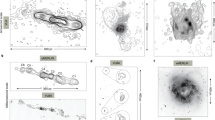Abstract
Radio sources can have such high luminosities that they are detectable at great distances. They may therefore be important tracers of the structure and evolution of the early Universe. They apparently evolve in time; compared with the present epoch, strong radio sources are orders of magnitude more common at redshifts z greater than unity1,2. Direct measurements of the number of radio sources observed as a function of their flux places constraints on both their evolutionary behaviour and on the cosmological models. To extend the present source counts to lower flux limits, the Very Large Array (VLA) of the National Radio Astronomy Observatory was employed. Thirteen widely separated fields at high galactic latitude were mapped at the VLA at 6 cm. The fields are 12.8 arc min square, and the 5σ noise levels extend below 1 mJy. The resulting differential source counts were ΔN/ΔN0 (0.5 mJy <S < 3.0 mJy) = 0.0384 and ΔN/ΔN0 (3.0 mJy < S < 10.0 mJy) = 0.178. These results confirm the deviation at low flux levels from the uniform N = 60 S−1.5 Ω distribution.
This is a preview of subscription content, access via your institution
Access options
Subscribe to this journal
Receive 51 print issues and online access
$199.00 per year
only $3.90 per issue
Buy this article
- Purchase on Springer Link
- Instant access to full article PDF
Prices may be subject to local taxes which are calculated during checkout
Similar content being viewed by others
References
Wall, J. V., Pearson, T. J. & Longair, M. S. Mon. Not. R. astr. Soc. 193, 683–706 (1980).
Wall, J. V. & Benn, C. R. IAU Symp. No. 97 441–449 (1982).
Peacock, J. A. & Gull, S. F. Mon. Not. R. astr. Soc. 196, 611–633 (1981).
Longair, M. S. Mon. Not. R. astr. Soc. 133, 421–436 (1966).
Peacock, J. A. & Wall, J. V. Mon. Not. R. astr. Soc. 194, 331–349 (1981).
Schmidt, M. Astrophys. J. Lett. 209, L55–L56 (1976).
Peacock, J. A. & Wall, J. V. Mon. Not. R. astr. Soc. 198, 843–860 (1982).
Wall, J. V., Pearson, T. J. & Longair, M. S. IAU Symp. No. 74, 269–277 (1977).
Wall, J. V., Pearson, T. J. & Longair, M. S. Mon. Not. R. astr. Soc., 196, 597–610 (1981).
Pauliny-Toth, I. I. K., Steppe, H. & Witzel, A. Astr. Astrophys. 85, 329–331 (1980).
Willis, A. G. & Miley, G. K. Astr. Astrophys. 76, 65–68 (1979).
Rots, A. NRAO Newslett. No. 6 (1 May, 1982).
Murdock, H. S., Crawford, D. F. & Jauncey, D. L. Astrophys. J. 183, 1–13 (1973).
Crawford, D. F., Jauncey, D. L. & Murdock, H. S. Astrophys. J. 162, 405–410 (1970).
Ledden, J. E., Broderick, J. J., Condon, J. J. & Brown, R. L. Astr. J. 85, 780–788 (1980).
Maslowski, J., Pauliny-Toth, I. I. K., Witzel, A. & Kuhr, H. Astr. Astrophys. 95, 285–294 (1981).
Wall, J. V., Scheuer, P. A. G., Pauliny-Toth, I. I. K. & Witzel, A. Mon. Not. R. astr. Soc. 198, 221–237 (1982).
Peacock, J. A. & Wall, J. V. Mon. Not R. astr. Soc. 194, 331–349 (1981).
Laing, R. A. & Peacock, J. A. Mon. Not. R. astr. Soc. 190, 903–924 (1980).
Author information
Authors and Affiliations
Rights and permissions
About this article
Cite this article
Bennett, C., Lawrence, C., Garcia-Barreto, J. et al. VLA source counts at 6-cm wavelength. Nature 301, 686–688 (1983). https://doi.org/10.1038/301686a0
Received:
Accepted:
Issue Date:
DOI: https://doi.org/10.1038/301686a0
This article is cited by
-
Shock-induced star formation in G357.7 – 0.1?
Nature (1985)
Comments
By submitting a comment you agree to abide by our Terms and Community Guidelines. If you find something abusive or that does not comply with our terms or guidelines please flag it as inappropriate.



